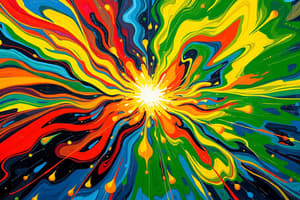Podcast
Questions and Answers
What primarily determines if a collision between reactants will lead to product formation?
What primarily determines if a collision between reactants will lead to product formation?
- The collision angle and the energy (correct)
- The volume of the container
- The color of the reactants
- The temperature of the surroundings
The transition state represents the highest energy point in a reaction.
The transition state represents the highest energy point in a reaction.
True (A)
What is the term for the maximum energy that reactants need to reach the transition state?
What is the term for the maximum energy that reactants need to reach the transition state?
activation energy
In an __________ reaction, the products have lower energy than the reactants.
In an __________ reaction, the products have lower energy than the reactants.
Match the type of reaction with the energy change:
Match the type of reaction with the energy change:
What is the 'collision theory' primarily concerned with?
What is the 'collision theory' primarily concerned with?
Increasing the concentration of reactants always guarantees a faster reaction.
Increasing the concentration of reactants always guarantees a faster reaction.
What is another term for the 'transition state'?
What is another term for the 'transition state'?
An endothermic reaction will feel _________ to the touch as it proceeds.
An endothermic reaction will feel _________ to the touch as it proceeds.
Match the graph type with the reaction type:
Match the graph type with the reaction type:
What is the significance of 'activation energy' in a chemical reaction?
What is the significance of 'activation energy' in a chemical reaction?
In exothermic reactions, energy is absorbed from the surroundings.
In exothermic reactions, energy is absorbed from the surroundings.
In a potential energy diagram, what does the peak represent?
In a potential energy diagram, what does the peak represent?
The spatial arrangement of reacting substances is referred to as _________.
The spatial arrangement of reacting substances is referred to as _________.
Match the energy levels with the respective reaction
Match the energy levels with the respective reaction
In an exothermic reaction, is the net energy emission from, or absorption to, the system?
In an exothermic reaction, is the net energy emission from, or absorption to, the system?
Activation energy lowers in the processes.
Activation energy lowers in the processes.
What type of processes are shown on the graphs in the book?
What type of processes are shown on the graphs in the book?
The minimum amount of energy needed for a chemical reaction to occur is termed ___________.
The minimum amount of energy needed for a chemical reaction to occur is termed ___________.
Choose the sentence with the corresponding process.
Choose the sentence with the corresponding process.
Flashcards
Activation Energy
Activation Energy
The minimum energy needed to cause an effective collision that breaks bonds.
Transition state / Activated Complex
Transition state / Activated Complex
A compound formed when reactants collide with enough energy to break bonds and rearrange atoms.
Collision Theory
Collision Theory
Collisions and spatial orientation of the reactants determine product formation.
Transition State
Transition State
Signup and view all the flashcards
Exothermic Process
Exothermic Process
Signup and view all the flashcards
Endothermic Process
Endothermic Process
Signup and view all the flashcards
Study Notes
Collision Theory
- According to collision theory, collision energy is a parameter that defines a reaction.
- Spatial orientation of reactants will impact the formation of products.
Energy Threshold
- The highest energy threshold reactants have is specific to each process.
- This is called the transition state, or activation complex.
- To generate new species, all bonds in the reactants must change.
- This happens the moment the reactant changes its nature.
Energy Profiles
- Energy profiles analyze energy based on reaction occurrence.
- The following are standard graphs of processes with energy emission and consumption.
Exothermic Process
- The graph accounts for a process where the energy of the products is less than that of the initial reactants.
- This results in energy emission to the environment.
Endothermic Process
- The products have more energy than the reactants.
- This implies a gain for the system from the environment's energy.
- This graph defines an endothermic process.
Activation Energy
- Both clarify the activation energy, the maximum energy threshold (activation complex), and the total energy balance.
Chemical Reaction Analysis
- Every chemical process with new substances forming necessarily involves a collision of particles or reaction substances.
- Several parameters need analysis and definition.
Reactants
- Reactants must collide with enough energy to break bonds and generate new substances.
- If the energy threshold is not met, the reaction does not occur.
Activation Energy
- Activation energy refers to the minimum energy needed for an effective collision that breaks bonds.
- Every chemical process needs this threshold for reactants to become stable products.
Studying That Suits You
Use AI to generate personalized quizzes and flashcards to suit your learning preferences.




